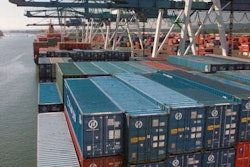Trucking news and briefs for Thursday, Feb. 22, 2024:
Car haulers get warning-flag exemption renewal
The Federal Motor Carrier Safety Administration is provisionally renewing an exemption requested jointly by the Automobile Carriers Conference (ACC) of the American Trucking Associations and the Auto Haulers Association of America (AHAA) to relieve motor carriers operating stinger-steered car-haul equipment from the requirement to place warning flags on projecting loads of new and used motor vehicles.
The Federal Motor Carrier Safety Regulations (FMCSRs) require any truck transporting a load that extends more than four feet beyond the rear of the vehicle be marked with a single red or orange fluorescent warning flag at the extreme rear if the projecting load is two feet wide or less and two warning flags if the projecting load is wider than two feet.
In its original exemption request, ACC noted that stinger-steered automobile transporters have been allowed to have a rear vehicular overhang of at least six feet since December 2015..
ACC contended that adhering to flag requirements while transporting new motor vehicles posed a challenge to the vehicle industry because manufacturers don’t want anything to scratch or damage the vehicles. The group added that reflectors equipped on cars being transported adequately meet the intention of the regulation requiring flags.
The waiver is provisionally renewed for six months through Aug. 9, 2024.
[Related: Stinger-trailer car haulers get relief from warning flag regs for overhanging loads]
DOT issues safety advisory after chemical tank ‘rockets’ 300 feet
The Federal Motor Carrier Safety Administration and the Pipeline and Hazardous Materials Safety Administration (PHMSA) on Tuesday issued a safety advisory to provide notice of the possibility of “catastrophic failure” of certain hazardous materials tanks commonly known as “nurse tanks.”
The agencies said the notice focuses on nurse tanks manufactured from Jan. 1, 2007, through Dec. 31, 2011, by American Welding and Tank (AWT) at its Fremont, Ohio, plant. Nurse tanks manufactured by AWT from 2009 to 2010 were the subject of a prior FMCSA investigation and enforcement action in response to improper manufacturing procedures.
On Aug. 23, 2023, a 2009 AWT nurse tank containing anhydrous ammonia experienced a catastrophic failure in a farm co-op lot, resulting in the release of all product. The failure caused the tank shell to “rocket” over 300 feet from its original location, the agencies said.
“While no injuries were reported, this event is an indicator of potential continuing problems with AWT nurse tanks that have now been in service for over a decade,” the notice said.
Following the incident, the owner of the involved nurse tank contracted with a third-party testing company to have their eight AWT nurse tanks manufactured between 2008 and 2012 tested, which showed “extreme stress corrosion cracking, porosity, and inclusions/voids in the welds where the heads and shells of the nurse tanks were joined,” the notice said, adding that only a 2012 tank passed.
The owner submitted those results to engineering experts who were involved in previous research funded by FMCSA into similar issues with this series of AWT nurse tanks and voluntarily placed the nurse tanks out of service.
The parent company of the farm co-op subsequently conducted similar radiographic testing on 142 AWT nurse tanks manufactured between 2007 and 2012, and 100 failed the test -- all 2012 tanks passed.
While current hazmat regulations do not require periodic inspection and testing of nurse tanks that have attached and legible American Society of Mechanical Engineers (ASME) identification plates, FMCSA and PHMSA are “strongly recommending that owners of AWT nurse tanks manufactured between Jan. 1, 2007, and Dec. 31, 2011, that are exempted from periodic inspection and testing requirements” conduct voluntary periodic visual inspections, thickness testing and pressure testing.
For owners of affected AWT nurse tanks unable to conduct voluntary pressure testing, the agencies recommend that either radiographic or ultrasonic testing be conducted. While the period of voluntary inspection and testing is at the discretion of the nurse tank owner, inspection and testing is recommended at least once every five years.
Classification expert rejoins NFMTA
The National Motor Freight Traffic Association (NMFTA) has welcomed Nate Ripke as director of commodity and standards development. A former employee of NMFTA, in this newly created role, he will lead strategy on simplifying the National Motor Freight Classification (NMFC) and enhance the user experience of ClassIT.
 Nate Ripke
Nate Ripke
In his first stint at the association, from 2011-2017, Ripke was heavily involved in the day-to-day operations of classification development and interpretation. He was also responsible for internal and external training on classification products. With over 17 years of experience with industry-leading businesses such as Holland, in addition to his own company, Handy Movin’ & Haulin’, Ripke has acquired an extensive skill set to help propel NMFTA forward, the group said.
While at Holland, he served as the manager for weighing and inspection, and during his previous NMFTA role, he served as a member of the Commodity Classification Standards Board.
His in-depth expertise in classification, which includes weighing and research, will serve the organization well as NMFTA continues its mission to further modernize and improve the existing NMFC system.
In his most recent role at Old Dominion, he served as regional manager weights and inspections and focused on the less-than-truckload (LTL) sector of the industry. He served as a regional expert in business process analysis, operational improvement, and freight classification.
While at NMFTA, he will be able to utilize his ability to help both domestic and global shipping clients manage their cargo and freight efficiently, with increased knowledge and a profound understanding of the best solutions.











